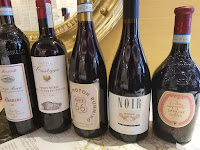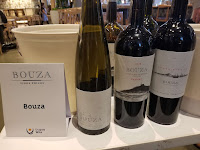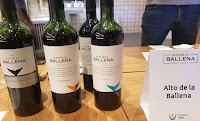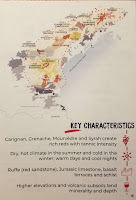 Last week I participated in an Uruguay Wine 101 seminar hosted by Uruguay Wine and INAVI (Instituto Nacional de Vitivinicultura) and presented by Martina Litta (Uruguay Wine - INAVI Foreign Trade Manager) and Joaquín Hidalgo (Wine columnist, La Nación - Argentina). The seminar itself was quite informative with a presentation on the country's wine regions and major wine grapes implemented using samples from nine producers, video greetings from each producer, and the participation of a couple winemakers. Definitely a worthy candidate for a case study in successful seminars.
Last week I participated in an Uruguay Wine 101 seminar hosted by Uruguay Wine and INAVI (Instituto Nacional de Vitivinicultura) and presented by Martina Litta (Uruguay Wine - INAVI Foreign Trade Manager) and Joaquín Hidalgo (Wine columnist, La Nación - Argentina). The seminar itself was quite informative with a presentation on the country's wine regions and major wine grapes implemented using samples from nine producers, video greetings from each producer, and the participation of a couple winemakers. Definitely a worthy candidate for a case study in successful seminars. Ms. Litta started the session by describing Uruguay and several general facts about this country.
- The name means “river of the painted birds” in the indigenous Guarani language.
- South America’s second smallest nation after Suriname with a similar surface area to Wisconsin.
- Population 3.4 million – a population close to that of Connecticut, but less than Brooklyn and Manhattan combined.
- Largely European heritage, primarily Spanish and Italian in origin.
- Cows outnumber humans in Uruguay 4 to 1 and Uruguayans consume more meat per capita than any other country in the world
- With 14,804 acres/5,991 hectares under vine, the wine regions are slightly larger than Saint - Émilion in Bordeaux and slightly smaller than Alexander Valley in California.
- The only South American terroir whose climate is affected by the Atlantic Ocean.
- 180 wineries are currently operating in the country. Most are family-run, with two-thirds located in the Metropolitan Region.
- More than 50% of the grape harvest in Uruguay is done by hand
- The vineyards of Maldonado are planted above some of the oldest rocks on earth, the Río de La Plata craton, which is 2.5 billion years old.
- Tannat is the most widely planted variety in Uruguay at 3,892 acres/1,575 ha and it is not offended by humidity.
- In Uruguay, Tannat is also known as Harriague (Ha-ree-AH-gay), the surname of the first producer to plant it in the country.
- The VCP label stands for Wine of Preferential Quality and distinguishes fine wines from mass-market versions.
The Regions:
- Metropolitan: 12,076 acres/4,887 ha
Includes departments of San José, Canelones, and Montevideo. Deep, clay soils also include strips of pink granite, making for a terroir well-suited to Tannat. - Oceanic: 1,053 acres/426 ha
Includes two departments, Maldonado and Rocha with a varied topography which is the primary factor in distinguishing its wines. The Cuchilla Grande is the highest point in Uruguay, reaching a height of 1,600 feet/488 m above sea level, contributing a mix of granite and ballast to the soils. The climate is oceanic where white varieties dominate. - Southern Riverside: 722 acres / 292 ha
Includes departments of Colonia, Río Negro, and Soriano. The influence of the Uruguay River can be seen in the sedimentary soils of Carmelo, while the San Juan River is distinguished by rockier soils. The region accounts for 5.2% of hectares under vine in Uruguay. Carmelo lies at the center of the southern shore. A dozen wineries are scattered throughout the area. Soils are distinguished by pockets of calcium carbonate deposits. Reds are the heart of the region. - Northern Riverside: 408 acres/165 ha
- Center: 109 acres/44 ha
- North: 84 aces/34 ha
The Rivera and Tacuarembó departments are planted in different geological formations, each rich in iron, comprising 84 acres/34 ha of vines, or 0.6% of the total. A continental climate with a significant thermal range. Experiences more hours of sunlight than any other region of Uruguay.
 Marichal Wines is a family-owned winery that was established in 1938 and is now in its third and fourth generation of family winemaking headed by winemakers Juan Andrés and Alejandro Marichal. The vineyards are located in the department of Canelones in the Metropolitan region. These vines benefit from warm weather, cool Atlantic breezes, and deep clay soil. The Marichal Sauvignon Blanc 2022 ($14) is very aromatic (citrus); dry, with juicy lemon and melons, some vegetable character; and finishing with chewy tannins.
Marichal Wines is a family-owned winery that was established in 1938 and is now in its third and fourth generation of family winemaking headed by winemakers Juan Andrés and Alejandro Marichal. The vineyards are located in the department of Canelones in the Metropolitan region. These vines benefit from warm weather, cool Atlantic breezes, and deep clay soil. The Marichal Sauvignon Blanc 2022 ($14) is very aromatic (citrus); dry, with juicy lemon and melons, some vegetable character; and finishing with chewy tannins.  Bracco Bosca is located in Atlantida in the Oceanic region and their 11-hectare vineyard is managed by fifth-generation grower Fabiana Bracco. These vines are located just eight kilometers from the ocean and this proximity is reflected in the surprising Bracco Bosca Ombú Moscatel 2022 ($16). This is a dry wine, with the expected floral and tropical aromatics but powered by salinity and creamy melons and pears. Excellent.
Bracco Bosca is located in Atlantida in the Oceanic region and their 11-hectare vineyard is managed by fifth-generation grower Fabiana Bracco. These vines are located just eight kilometers from the ocean and this proximity is reflected in the surprising Bracco Bosca Ombú Moscatel 2022 ($16). This is a dry wine, with the expected floral and tropical aromatics but powered by salinity and creamy melons and pears. Excellent.  In 1979 Familia Deicas took over the historic 18th-century estate and winery of Establecimiento Juanicó -- rejuvenated that brand and launched their own Familia Deicas brand in 2000. Here they focus on premium wines with low intervention winemaking from third-generation vigneron Santiago Deicas and utilize multiple vineyards in various regions in Uruguay. One of these vineyards is the Sierra de Mahoma, San José - located in western Montevideo. This vineyard is called the “sea of stones” because it looks like a sea bed with loam soils that are covered in gravel and almost vertical schist. The low fertility and limited water-storing capacity mean that these vineyards produce a very low yield of very concentrated grapes. This minerality is evident in the Familia Deicas Bodegones del Sur Vineyards Select Cabernet Franc 2020 ($20) which also includes a minty aroma and juicy herbaceous and red fruit flavors. 30% of the wine was aged in American and French oak barrels --providing greater roundness.
In 1979 Familia Deicas took over the historic 18th-century estate and winery of Establecimiento Juanicó -- rejuvenated that brand and launched their own Familia Deicas brand in 2000. Here they focus on premium wines with low intervention winemaking from third-generation vigneron Santiago Deicas and utilize multiple vineyards in various regions in Uruguay. One of these vineyards is the Sierra de Mahoma, San José - located in western Montevideo. This vineyard is called the “sea of stones” because it looks like a sea bed with loam soils that are covered in gravel and almost vertical schist. The low fertility and limited water-storing capacity mean that these vineyards produce a very low yield of very concentrated grapes. This minerality is evident in the Familia Deicas Bodegones del Sur Vineyards Select Cabernet Franc 2020 ($20) which also includes a minty aroma and juicy herbaceous and red fruit flavors. 30% of the wine was aged in American and French oak barrels --providing greater roundness.
Gimenez Mendez is a family winery where the first vines were planted in 1950 and today is run by Marta Marta Méndez Parodi and her youngest son Mauro Giménez Méndez. The winery specializes in Tannat grown in Las Brujas, a sub-region in Canelones, and, in fact, currently releases seven different styles of Tannat. Summers are dry in Las Brujas with high daytime temperatures which shift to the colder side in the evenings from the cool coastal breezes. This enhances acidity that is abundant in the Giménez Méndez Alta Reserva Tannat 2020 ($18). Also expect ripe red fruit and a slight black pepper and tobacco nose, followed by plums and other black fruit, the aforementioned juicy acidity, and solid tannins.
 Winemaking in the Toscanini family descends over 100 years into the past when the patriarch of the family emigrated from Italy and settled in the department of Canelones, producing his first wine in 1908. Seven decades later (in 1979), Margot Toscanini de Montes and her brother acquired the current winery in Las Piedras, giving rise to Montes Toscanini. And in 1995, the responsibility of the winery descended to Enól. Leonardo Montes Toscanini, who along with other members of the fourth generation of the family, has run the winery to this day. The grapes for the Montes Toscanini Gran Tannat Premium 2019 ($59) are grown in Altos de La Ballena where the soils are predominantly clay-loam with some calcareous material and have a gentle slope. In addition, the proximity to the River Plate provides maritime and estuary influence with mild and steady temperatures throughout the year. This Gran Tannat is an impressive wine made using classical production methods. Expect more black pepper; creamy red fruit, great depth, and juicy and approachable tannins.
Winemaking in the Toscanini family descends over 100 years into the past when the patriarch of the family emigrated from Italy and settled in the department of Canelones, producing his first wine in 1908. Seven decades later (in 1979), Margot Toscanini de Montes and her brother acquired the current winery in Las Piedras, giving rise to Montes Toscanini. And in 1995, the responsibility of the winery descended to Enól. Leonardo Montes Toscanini, who along with other members of the fourth generation of the family, has run the winery to this day. The grapes for the Montes Toscanini Gran Tannat Premium 2019 ($59) are grown in Altos de La Ballena where the soils are predominantly clay-loam with some calcareous material and have a gentle slope. In addition, the proximity to the River Plate provides maritime and estuary influence with mild and steady temperatures throughout the year. This Gran Tannat is an impressive wine made using classical production methods. Expect more black pepper; creamy red fruit, great depth, and juicy and approachable tannins.
Pisano Wines also shares a century of winemaking tradition - this time in Progreso in Canelones - and is operated by three Pisano brothers: Gustavo, the winemaker; Eduardo, the agronomist; and Daniel, the export manager. The family traces their heritage to Italian and Basque immigrants - this later from the group of people who introduced Tannat to Uruguay. Again like Montes Toscanini, the Pisano wines benefit from the Río de la Plata (River Plate) - an estuary formed by the confluence of the Uruguay River and the Paraná River at Punta Gorda. The Pisano Reserva de la Familia Tannat 2018 ($24) is a fresh and well-rounded wine with light and chewy sour cherries that alternate with darker fruit and soft tannins.

Alto de la Ballena is a small winery operating in the Sierra de la Ballena located just 15 kilometers from the Atlantic coast. The small 8-hectare estate vineyard benefits from the oceanic air as well as excellent drainage from the steep, granite, and schist hillside mountain soils. The winery's birth is dated at the Millenium when Paula and Alvaro quit their finance jobs after spending the previous two years searching for the ideal vineyard location. They found that in the Maldonado department in the Oceanic region. They showed an interesting wine in the Alto de la Ballena Tannat – Viognier 2018 ($24) - an 85-15% blend. They manage both lots so that they can be harvested very close together allowing for co-fermentation. The Viognier adds a more intense aroma and softens the Tannat's tannins creating a lovely wine. Still structured with juice acidity, some herbs, and juice and chewy sour cherries.

Bodega Bouza is an innovative winery and the very first to plant Albariño in Latin America to incorporate the family's Spanish roots from Galicia. They also farm several other winegrapes in five vineyards from the metropolitan areas of Montevideo and Canelones to the oceanic-influenced Maldonado region. These are Pinot Noir, Chardonnay, Riesling, Merlot, Tempranillo, and Tannat. The last three comprise their Bouza Monte Vide Eu (Tempranillo - Merlot - Tannat) 2019 ($67) - a full-bodied and structured wine providing a robust mouthfeel. This is structured at 50% Tannat, 30% Merlot, and 20% Tempranillo and the grapes are vinified and initially aged separately then aged together for a total of up to 16 months in French and American oak barrels. This is an exceptional Oceanic wine.

Basta Spirit was founded in 2018 and produces spirits using a Tannat base. The Basta Spirit Vermut Flores Rosé ($16) contains 27 botanicals, including flowers such as hops, chamomile, rose, and elderberry. It is extremely aromatic, with loads of herbaceousness and forest spiciness - very gin-like. I plan on using this in a Negroni, and replacing the gin with mezcal, since this Vermut has suitable gin flavors.


















































